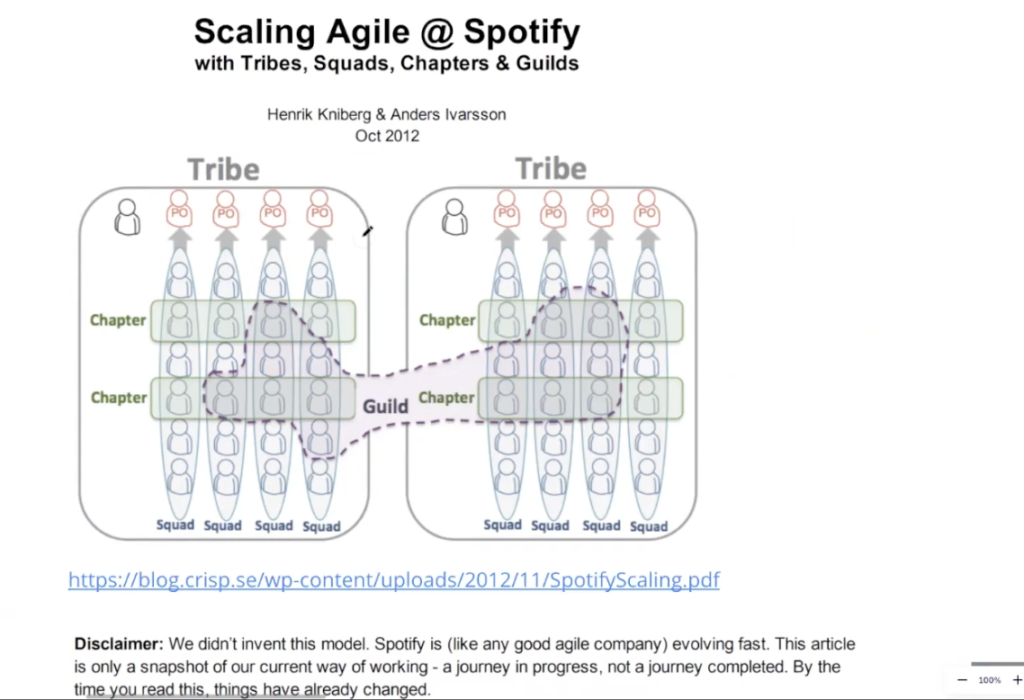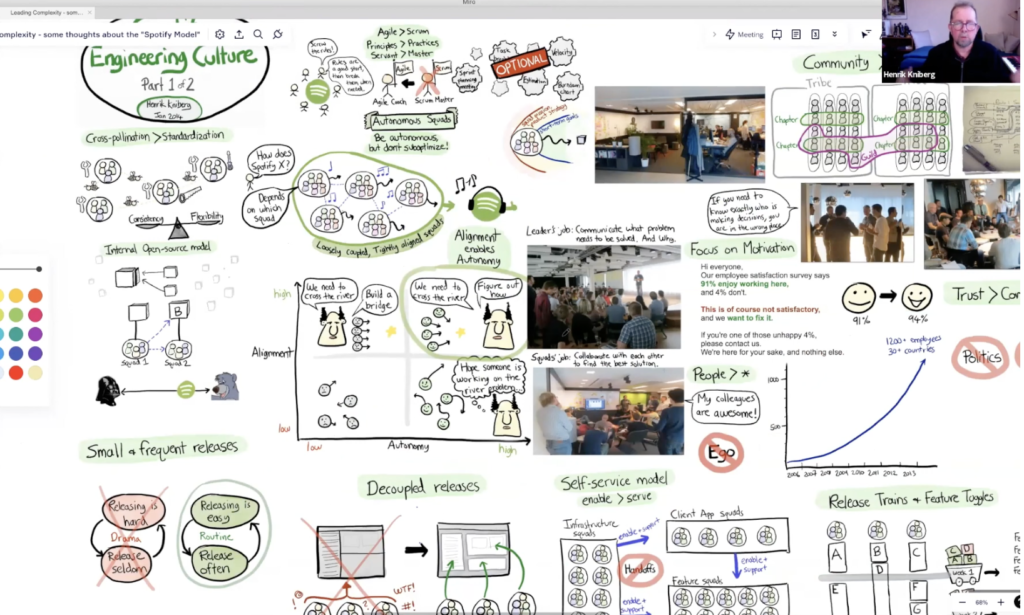
The Spotify Model. You have probably heard the term. But how did it come to life? How did it become a “thing”? What are the principles behind it? What happens when companies copy it? Should you copy it?
To kick off this series of summaries of the Leading Complexity program, we focus on Henrik Kniberg’s talk and highlight five key takeaways.
Let’s hear what Henrik has to say.
Watch the full-length Master Class below and check the accompanying Miro board
Empowering Autonomous Innovation By Decoupling Principles from Methods

The Master Class starts off with Henrik championing the importance of decoupling principles from methods. He talks about how doing just that is the key to minimizing the gap between the maker, and the user.
How? For instance, taking the principle of autonomous teams, closely related to Scrum, and applying it to other methods, such as Kanban.
“What I think is nice is that (…) you don’t have to do Scrum to have autonomous teams. Decoupling the principles from the actual methods is quite useful.”
He highlights that doing so can help teams work faster, empowering them to make efficient decisions. All for the purpose of creating a more seamless and consistent user experience.
Team of Teams

Henrik continues to speak about the importance of empowering teams within the organization. All for the purpose of making decisions and acting autonomously. In other words, he describes a team of teams.
Henrik goes even further, explaining that this approach allows for a more agile and adaptive organization as well as a more engaged and motivated workforce.
“Weird words are kind of deliberate because that forces people to ask and don’t bring preconceived notions.”
Additionally, he explains that giving specific names to the different teams within the organization is a great idea. This approach forces people to ask what the terminology means. That helps to avoid preconceived ideas. And that allows the organization to remain agile while preventing reliance on outdated practices.
Adapting Principles for Your Context
Moving on, Henrik continues highlighting the most relevant aspects people need to understand about this framework. For example, the model asserts the importance of experimentation and adaptation to stay ahead of the curve and innovate. He explains that the approach is based on the idea that there is no one-size-fits-all solution. Furthermore, he underlines the fact that processes are always evolving. So by constantly testing and iterating on new approaches, Spotify was able to find one of the most effective ways of working. Hence the whole attention the model received.
But what’s important to note, as Henrik says, is that the model needs to be adapted to fit one’s specific context.
“It’s about planting seeds, inspiring people, and letting go of control.”
Instead of copying the model by the letter, it’s important to modify it and make it fit each context. And this can easily be done by getting inspiration from multiple sources. Doing just that allows each organization to tailor the model to fit their unique situation and needs.
Leadership: Trust, Transparency, Structure

Another very important aspect of the Spotify model is strong leadership. The model is about leadership that emphasizes trust, self-organization, and a forward-thinking structure. All to promote efficiency, effectiveness, engagement, and motivation. The framework is about leaders who lead by example, fostering a culture of trust. It’s about transparency while empowering employees to take ownership of their work.
More importantly, the model encourages teams to make decisions and take action without approvals from higher-ups.
“The model was created before it was needed.”
Henrik talks about the fact that in the early days of Spotify the CTO wanted to build a structure to grow into. That led to creating the whole model before it was needed. And that turned out to be a necessary decision and the right choice.
Innovating in Complexity
To wrap things up, Henrik speaks about how the Spotify Model is optimized for complexity. Therefore, it is a framework created to promote the speed of innovation. And as he highlights throughout the whole talk, this is the key strategy for dealing with a complex world.
So the big secret behind this model is easy to understand. The Spotify Model is about empowering teams to make decisions. It’s about decoupling principles from methods. It’s about creating a structure for growth. And last but not least, the Spotify Model is about avoiding preconceived ideas.
“We aim to make mistakes faster than anyone else.”
Daniel Ek
Thus, as the Spotify CEO also preaches, organizations should not apply models blindsided. As a matter of fact, the goal each business should have in mind should be to make mistakes faster than anyone else. Doing so will allow them to handle complex situations with autonomy. It will allow them to make rapid decisions and continuously improve.
And the successful implementation of the Spotify Model is to look at it just as a source of inspiration. It is to take it as a starting point but to fit it into the company’s unique context and needs. Because doing just that creates a powerful tool for promoting innovation and handling complexity.




Thanks for sharing, this information is very valuable for my agile program.